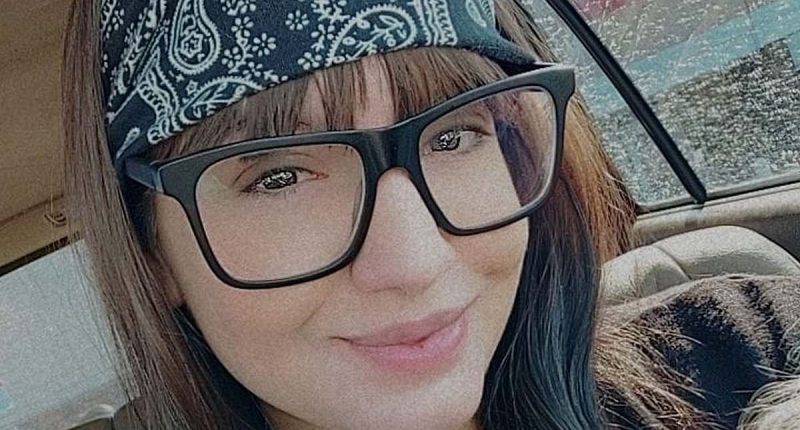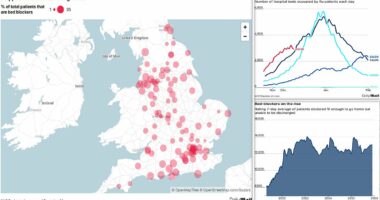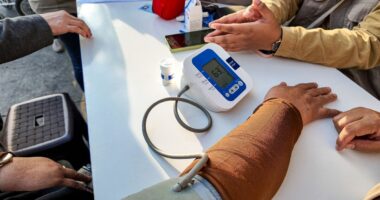Share this @internewscast.com
Mandi Masterpole was one of 16 million Americans taking ADHD medications — the only catch? She didn’t have the disorder.
She took drugs like Adderall and Ritalin without a prescription, using them to power through schoolwork, juggle babysitting jobs, and stay energized for parties.
By 22, Masterpole suffered a devastating heart attack after five years of abusing the stimulants — which she likened to ‘legal speed.’
‘I bought a few and I tried them and that was it. I remember my eyes lighting up, the colors seemed to be brighter,’ said Masterpole from Hamilton, New Jersey.
‘Everything seemed to be bright. I thought it was like heaven. I was like, “Oh my god, this is amazing.”’
One pill a day quickly became two as she chased that initial high.
Eventually she was snorting the drug four times a day with most of her $600 weekly paycheck going towards the cost.
ADHD drugs such as Ritalin, Adderall, and Vyvanse are designated schedule II drugs under the Controlled Substances Act.

Mandi Masterpole began abusing Adderall and Ritalin when she was 17. She enjoyed it for its ability to keep her awake and alert to keep up with her school work while also spending time with friends and partying
For people with attention deficit hyperactivity disorder (ADHD), they can be valuable medical tools as they simply replenish depleted levels of chemicals in the brain that help patients concentrate.
But for those who don’t have the disorder, they overstimulate the brain with pleasure hormones, leading to performance-enhancing effects and an addictive euphoric ‘high’ that can prove dangerous.
Masterpole would take the drugs, typically crushed up and snorted, for six days a week.
‘It got to the point where I would make a schedule. I would stop the pills on Tuesday, because I was off work on Wednesday,’ she said.
‘So I would stop on Tuesday, I would take Wednesday to eat and then I would start my pills again. I needed to take a day to eat because I wasn’t eating anything.’
The drugs decimated her appetite with her weight plummeting from a healthy 140 lbs to a stick-thin 114 lbs.
The drugs were also doing insurmountable damage under the surface.
Aged 21, she became unexpectedly pregnant with her daughter, Shea, and though she says she stopped taking the drugs during her pregnancy, by that point the damage to her heart muscle was done.
‘I knew when I went into labor, I was telling my mom, “something’s not right”,’ Masterpole recalled.
‘The doctors asked me if I had taken anything, I ended up telling them that I had abused drugs and they basically said I had blown out my heart.’
On top of that, she was a type 1 diabetic and had not been taking her insulin as needed.

‘I would tell people to steer clear of these drugs completely. It’s not worth it. It may make you feel good but it’s going to tear everything apart,’ Masterpole, now 34, said. She is pictured with her daughter Shae
‘The drugs had weakened my heart, plus the diabetes had made it so weak that when I went into labor my body couldn’t handle it,’ Masterpole said.
Years of heavy drug use in addition to mismanaging her diabetes made the young woman’s heart ‘ridiculously weak,’ the doctor told her.
‘There was nothing to it,’ she said. ‘He was like, “you just shattered it.”’
Now, the 34-year-old often requires a wheelchair to get around as her weakened heart has left her with fatigue and shortness of breath.
She can’t have any more children due to the stress it would impose on her depleted body.
Masterpole is looking back on her experience in the hope of educating young people who opt to start taking the drugs without a doctor’s order just to get ahead in academics or to party.
The irony, Masterpole says, is that even though she was abusing her body, she was excelling in her school work and social life.
She worked and studied all day to become a mortician but was still able to see her friends and party at night.

Years of heavy drug use in addition to mismanaging her diabetes made the young woman’s heart ‘ridiculously weak,’ the doctor told Masterpole

After her heart stopped twice, doctors implanted an LVAD—a mechanical pump that supports a failing heart—to keep her alive
‘Here I am telling myself I’m doing the right thing getting school done but I was blowing my heart out the whole time.’
Adderall and similar drugs boost concentration by increasing dopamine (motivation, focus, and reward) and norepinephrine (alertness and attention), helping the brain prioritize tasks and ignore distractions.
‘I was telling myself, I’m getting so much done, I have time, I can still party, I can still hang out, I can get up and go to work.’
She was making money babysitting at the time and figured that, as long as she could still be a proper caregiver, her drug use wasn’t be problematic.

Adderall and similar drugs boost concentration by increasing dopamine (motivation, focus, and reward) and norepinephrine (alertness and attention), helping the brain prioritize tasks and ignore distractions
‘It’s not like I’m nodding off in class, it’s not like I can’t see the kids. I’m washing them, I’m changing diapers, I’m doing everything I need to do,’ she recalled thinking.
But taking Adderall in high doses puts undue stress on the heart, speeding it up and raising blood pressure, which over time can cause the heart muscle to thicken.
Amphetamines like Adderall and Ritalin also cause blood vessels to constrict, which reduces the supply of oxygen getting to the heart.
And they disrupt the regular electrical activity in the heart, causing a life-threatening disruption to normal rhythm known as ventricular tachycardia or fibrillation.
Stimulants can also cause spasms in the heart arteries, cutting off the flow of blood even without any buildup of plaque there, which exacerbates heart damage.
At the height of her addiction, Masterpole did not consider any of this and it led to irreparable damage.

Masterpole, pictured with her daughter when she was a newborn, remains on the heart transplant wait list
After giving birth to her daughter, her heart stopped twice during a week in the hospital and she was taken to the operating room to have a Left Ventricular Assist Device, or LVAD, implanted.
The device helps the heart mechanically circulate blood when the left ventricle – the heart’s main pumping chamber – is too weak to function effectively.
Masterpole also had a pacemaker and defibrillator installed in her heart when she was 29.
A pacemaker acts like a metronome for the heart, sending small electrical pulses to maintain a steady beat. And a defibrillator monitors the heart’s rhythm 24/7.
She is now on a waiting list for a heart transplant, which, in some cases, can take years.
She remains at the bottom of the list due to the fact that the interventions have worked so far.
And while she is doing better now, Mandi had to put her dreams on hold. Unable to finish her mortuary schooling, she returned later but found it too difficult to balance with her many health needs.
‘I would tell people to steer clear of these drugs completely. It’s not worth it. It may make you feel good but it’s going to tear everything apart,’ Masterpole warned.
‘It’s not the quick fix I thought it was. Everybody should know it’s not what you think, it will lead you down a way that you do not want to go.’














